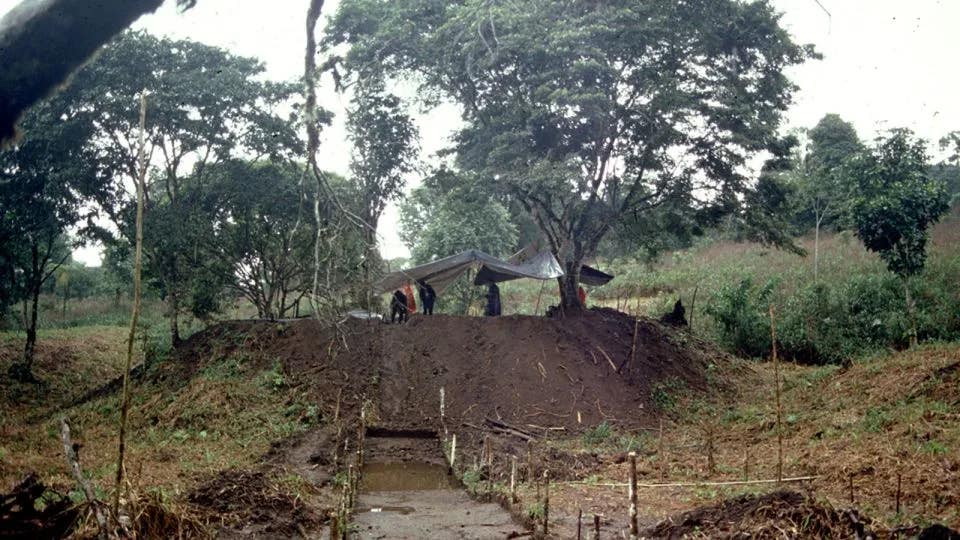Scientists discover 2,500 year-old network of interconnected cities within the Amazon rainforest
The Amazon rainforest once thrived as a sprawling network of interconnected cities, dating back over 2,500 years.

The Amazon rainforest once thrived as a sprawling network of interconnected cities, dating back over 2,500 years. Earth platform of the Sangay site, Upano Valley, Ecuador, during large-scale archaeological excavation. (CREDIT: Stéphen Rostain)
In a groundbreaking discovery that has left the scientific community astounded, a study spanning more than two decades has unearthed compelling evidence that an ancient site deep within the heart of the Amazon rainforest once thrived as a sprawling network of interconnected cities, dating back over 2,500 years.
This extraordinary revelation was unveiled in a recent publication in the prestigious journal Science, where the researchers detailed their extensive efforts in mapping this intricate web of settlements. It is suggested that this may represent the earliest documented example of urbanism in the Amazon.
"It was a lost valley of cities," exclaimed Stéphen Rostain, the lead author of the study and a director at France's National Center for Scientific Research, as he marveled at the findings. The research team's exhaustive work led them to identify at least 15 distinct settlements seamlessly connected by a network of roads stretching 10 to 20 kilometers in length. Some of the largest thoroughfares measured an impressive 10 meters in width.
This LIDAR image provided by researchers in January 2024 shows a main street crossing an urban area, creating an axis along which complexes of rectangular platforms are arranged around low squares at the Copueno site, Upano Valley in Ecuador. (CREDIT: Antoine Dorison, Stéphen Rostain via AP)
Intriguingly, the study documented more than 6,000 earthen platforms meticulously arranged at the site in Ecuador. These platforms, archaeologists believe, served a multitude of purposes, from plazas and ceremonial buildings to residences. They were intricately integrated into the road system and encircled by expansive, terraced fields and intricate drainage ditches.
What emerges from this research is a picture of a complex urban layout, pointing toward large-scale agriculture and a thriving population. It is estimated that the hub of these ancient cities may have housed around 10,000 farmers at its zenith, although some speculate that this number could have swelled to as many as 15,000 or even 30,000 individuals.
Archaeologist Antoine Dorison, a co-author of the study, aptly compared the population of this Amazonian site to that of Roman-era London, highlighting its significance in the context of its time.
Related Stories
Remarkably, this thriving Amazonian urban center persisted for roughly a millennium, from approximately 500 BC to somewhere between 300 and 600 AD, a timeline that aligns with the height of the Roman Empire in Europe. The density of occupation and the sophistication of the society, as suggested by this discovery, set it apart as a remarkable find in the Amazon region.
University of Florida archaeologist Michael Heckenberger, who was not involved in the study, lauded the findings, saying, "This shows a very dense occupation and an extremely complicated society. For the region, it's really in a class of its own in terms of how early it is."
While the inhabitants of these ancient Amazonian cities are believed to have belonged to the Kilamope and later Upano cultures, there remains much mystery surrounding their way of life.
Large-scale archaeological excavation on one earth platform of the Kilamope site, Upano Valley, Ecuador. (CREDIT: Stéphen Rostain)
The archaeological excavation yielded a treasure trove of artifacts, including pits, hearths, jars, grindstones, and burnt seeds, shedding light on their daily existence. The inhabitants' diet likely consisted of maize and sweet potatoes, and they are believed to have brewed a sweet beer known as "chicha."
Remarkably, the first author of the study, Stéphen Rostain, was the very archaeologist who discovered this site over two decades ago. However, recent advancements in light detection and ranging (LIDAR) technology have allowed scientists to peer through the dense Amazonian canopy, offering an unprecedented view of these ancient sites.
Kunguints site, Upano Valley, Ecuador. Complexes of rectangular platforms are arranged around low squares and distributed along wide dug streets. (CREDIT: Stéphen Rostain and Lidar A. Dorison)
Through LIDAR mapping, the research reveals a landscape that still bears the unmistakable imprint of human hands, even millennia after its heyday, despite the absence of substantial material remains.
It is important to note that unlike the Inca civilization, which constructed with stone, Amazonian societies often lacked this resource, turning instead to mud as their primary building material.
Researchers describe more than 6000 earthen platforms distributed in a geometic pattern connected by roads and intertwined with agricultural landscapes and river drainages in the Upano Valley. (CREDIT: Science)
As archaeologist José Iriarte, who was not involved in the research, explained, "The Inca left behind monumental stone constructions, but the Amazonians, in their own way, built greatness with mud."
Iriarte aptly likened the discovery of these cities to a revelation on par with discovering another Mayan civilization. However, this ancient Amazonian civilization boasts entirely unique architectural styles, land use practices, and ceramics.
The authors of this groundbreaking study express their hope that it will prompt a reevaluation of preconceived notions about the Amazonian world, revealing the staggering complexity and diversity of the peoples who once inhabited this lush rainforest.
Their research emphasizes the importance of recognizing the dual heritage of Amazonia, both environmental and cultural, underscoring the rich Indigenous history that has long been underestimated.
This discovery serves as yet another vivid reminder of the untold stories concealed within the heart of the Amazon rainforest, waiting to be unveiled by the relentless pursuit of science and exploration.
For more science stories check out our New Discoveries section at The Brighter Side of News.
Note: Materials provided above by the The Brighter Side of News. Content may be edited for style and length.
Like these kind of feel good stories? Get the Brighter Side of News' newsletter.
Joshua Shavit
Science & Technology Writer | AI and Robotics Reporter
Joshua Shavit is a Los Angeles-based science and technology writer with a passion for exploring the breakthroughs shaping the future. As a contributor to The Brighter Side of News, he focuses on positive and transformative advancements in AI, technology, physics, engineering, robotics and space science. Joshua is currently working towards a Bachelor of Science in Business Administration at the University of California, Berkeley. He combines his academic background with a talent for storytelling, making complex scientific discoveries engaging and accessible. His work highlights the innovators behind the ideas, bringing readers closer to the people driving progress.



